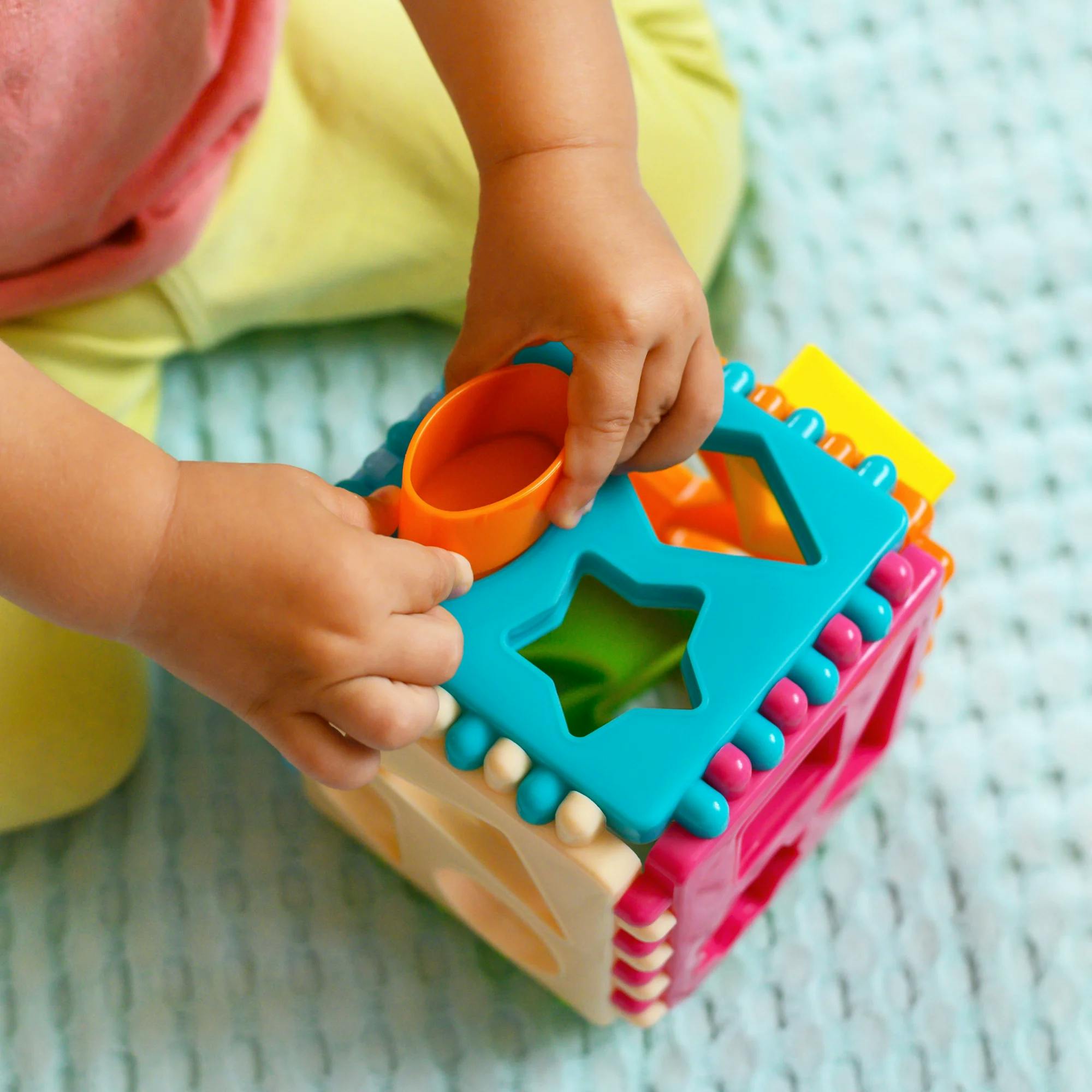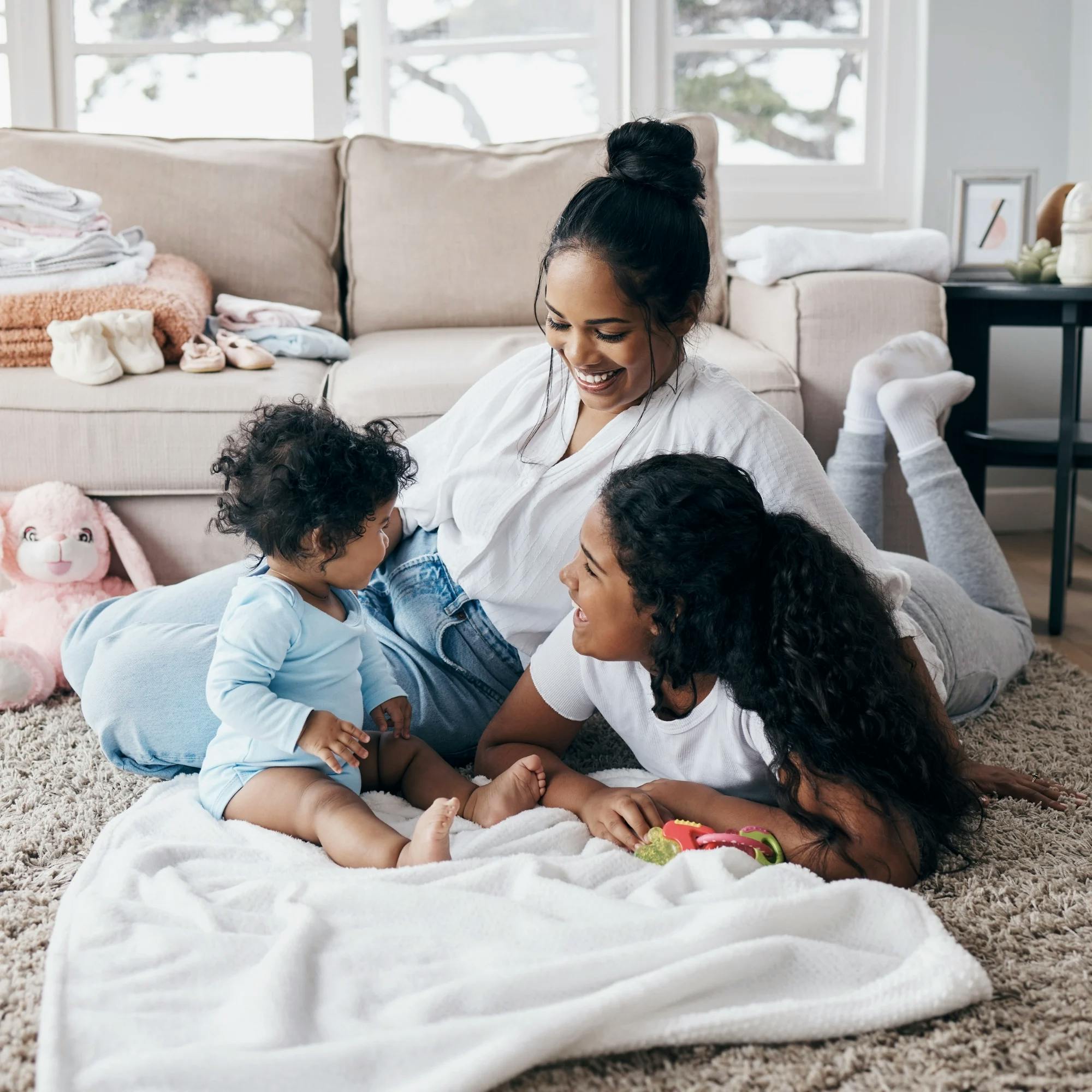Looking for the best toys for your 9-month-old baby? You’re in the right place. At this age, babies are learning through movement, play, and connection, and the right toys can support those exciting changes. As speech-language pathologists, we’re here to guide you to the best toys for 9-month-olds, along with expert tips on how to use play to support your baby’s early speech and language development.
By 9 months old, many babies are sitting up on their own, starting to crawl, and using their hands to explore. They’re also beginning to understand object permanence, respond to their name, and look for things you hide, making playtime even more meaningful. The American Academy of Pediatrics recommends a variety of sensory experiences at this age to help babies continue building motor, cognitive, and social skills.
So, what toys should a 9-month-old have? What play activities will keep them interested and help their development? Read on for our top expert-recommended toy picks and practical ways to support your baby’s communication during everyday play.

What are the best toys for 9-month-olds?
Here are some expert-recommended toys that support your baby’s development, and how to use them to encourage speech and language skills.
1. Pound-a-ball toy: Use the hammer to hit the ball and watch it drop through the tubes or slide. Practice:
Exclamatory words, like “boom!”
Item names, like ball and hammer
Function words, like more and all done
Basic concepts, like on and down
2. Push-and-go cars: Drive these cute cars around on the floor, couch, or bed. You can model, or demonstrate, this language for your baby:
Action words, like “drive” and “park”
Item names, like car and turtle
Vehicle noises, like “vroom” and “beep!”
Function words, like more and push
Basic concepts, like fast/slow


3. Soft stacking blocks: Show your baby how to stack blocks, then knock them over so they fall! Practice:
Exclamatory words, like “boom!” and “uh-oh!”
Item names, like block
Function words, like put on
Basic concepts, like on top and up
4. Shape sorter: Push shapes through the sorter while describing what you and your baby are doing. Practice:
Descriptive words, like big and smooth
Item names, like square and star
Prepositions, like “star goes in the hole!”
Function words, like more and push
Basic concepts, like open/close when playing with the lid


Why is play important for speech and language development?
Play isn’t just fun…it’s how babies learn about the world. And it’s one of the most important ways they build early speech and language skills.
When you play with your baby, you’re helping them learn how communication works. Simple things like taking turns, making eye contact, and using sounds or gestures all help your baby understand how to connect with others. These are the building blocks for talking later on.
Keep reading for fun and easy play ideas that can boost your baby’s communication every day!
How do you play with a 9-month-old to support language?
Now that you know what toys to use, here’s how to use other items during playtime.
Play with household items with your baby
Your home is full of everything you need to promote language development in your 9-month-old. As you go about your day, label the names of items and show your baby how you use them. Here are some more ideas to spark your imagination!
Stack plastic food storage containers or cups, then knock them over.
Play “kitchen” by mixing a spoon in a bowl and pretending to eat.
Play peek-a-boo with a blanket.
Tickle your baby to teach them anticipation
Tickling your baby can be a playful way to engage with them. It’s a great opportunity for eye contact, smiling, and laughing. These social cues help babies learn about communication and strengthen their bond with you.
After awhile, your baby will start to anticipate the joy and connection associated with this simple activity. The repetition of tickling + laughter also helps your baby understand cause and effect, which is a foundational skill for communication.
An important note: Every baby is unique, and responses to tickling may vary. Pay attention to your baby’s cues to be sure this type of play is enjoyable for them.
Make swing time more interactive
Playtime outside is fun for everyone! When you’re pushing your baby in a swing, stand in front of them so you’re face to face. After a few pushes, hold the swing and pause. Say, “Ready, set…,” and teach your baby the sign for “go!” or “more!” as you say the word aloud. Then let go and let your baby swing. Repeat this process to make swing time more interactive.
Nine-month-olds are at just the right age to start learning baby sign language. Using signs helps them communicate their wants and needs, which can cut down on frustration for everyone!
What are the best books to read to a 9-month-old?
The importance of reading to your baby can never be overstated. For infants and early talkers, books with photos of everyday items or animals are perfect. The images help babies learn the names of things they often see and use.
When you’re reading with your 9-month-old, point to the page to show what you’re talking about. Discuss the story out loud so they get good exposure to vocabulary words and how we structure our language. If your baby points to a picture or seems interested in it, make sure to respond and focus on that picture. Try these tips with any of these favorite books!
Brown Bear, Brown Bear, What Do You See?
You can also check out this quick video, where one of our speech therapists demonstrates a few of these tips with Where’s Spot?, a favorite board book for babies and toddlers.


How many toys does a 9-month-old need?
When it comes to the number of toys a baby should have, less is more. Research shows that fewer toys in a child’s environment can lead to better attention, more creativity, and overall higher-quality play.
Your everyday interactions with your baby matter most
As your baby’s parent or caregiver, you are in the best position to support their speech and language development. In fact, research has shown that children learn language best from the people they love most.
At Expressable, our speech therapists specialize in supporting families through every stage of development. Whether you're wondering how to support your baby's first words or just want play-based ideas backed by experts, we’re here to help.
Take the next step
Take our free communication screener for babies and toddlers
Learn more about language milestones by month
You're already doing something amazing by playing and engaging with your baby. Let us support you in making the most of it.
Curious or concerned?
Our free screener is tailored by age and covers all areas of speech, language, and feeding. Find out if your child might need speech therapy.
 Screener for children
Screener for childrenFAQs about toys and language development for 9-month-olds
1. What toys should a 9-month-old have?
At 9 months old, babies are learning through movement, touch, and interaction. Choose toys that are safe to explore and help build new skills. Great options include push-and-go cars, soft stacking blocks, shape sorters, and toys with balls or hammers. These toys help with fine motor skills, problem-solving, and early speech and language development.
2. How do toys help my baby learn to talk?
Toys give babies chances to hear and practice new words. During play, you can model simple words, sounds, and gestures. For example, saying “vroom” while pushing a car or “uh-oh!” when blocks fall helps babies connect words with actions. This builds the foundation for future talking.
3. How should I play with my 9-month-old to help them learn?
Follow your baby’s lead and talk about what they’re doing. You can label objects, describe actions, and repeat sounds. Try using household items like bowls and spoons for pretend play. Simple games like peek-a-boo or stacking cups also teach turn-taking, cause and effect, and new vocabulary.
4. Is a 9-month-old too young to read books with?
It's never too early to start reading with your baby! Choose sturdy board books with real photos, simple words, and textures to touch. Favorites include Brown Bear, Brown Bear, What Do You See?, Moo, Baa, La La La!, and First 100 Words. Point to pictures, talk about what’s on the page, and follow your baby’s interests during reading time.
5. How many toys does a 9-month-old really need?
Not many! Too many toys at once can be overwhelming. A few well-chosen, age-appropriate toys encourage better focus and creative play. Rotate toys every few days to keep things fresh and interesting. The most important part of play is the interaction between you and your baby.
How Expressable Can Help
Concerned your child isn't reaching age-expected milestones? Looking for communication support from a professional? Expressable is a national online speech therapy practice serving children and adults. We treat all major areas of communication and feeding, offer flexible hours including evenings and weekends, and accept most major health insurance plans. We’re proud to have earned more than 3,000 5-star reviews from our clients (4.9/5 average).
Our therapy model is centered on parent and caregiver involvement. Research proves that empowering caregivers to participate in their loved one’s therapy leads to better outcomes. That’s why we combine live, 1-on-1 speech therapy with personalized education and home practice activities for faster progress.
Communication is more than words. It’s how we share how we feel and show who we are. We’re here to help you or your child do just that.
 Alexis Irazoque, M.S., CCC-SLP
Alexis Irazoque, M.S., CCC-SLP















